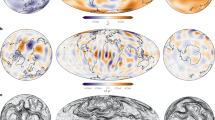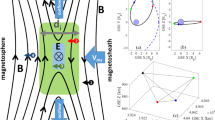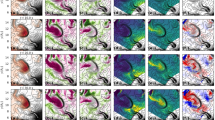Abstract
Convection is a fundamental physical process in the fluid cores of planets. It is the primary transport mechanism for heat and chemical species and the primary energy source for planetary magnetic fields. Key properties of convection—such as the characteristic flow velocity and length scale—are poorly quantified in planetary cores owing to the strong dependence of these properties on planetary rotation, buoyancy driving and magnetic fields, all of which are difficult to model using realistic conditions. In the absence of strong magnetic fields, the convective flows of the core are expected to be in a regime of rapidly rotating turbulence1, which remains largely unexplored. Here we use a combination of non-magnetic numerical models designed to explore this regime to show that the convective length scale becomes independent of the viscosity when realistic parameter values are approached and is entirely determined by the flow velocity and the planetary rotation. The velocity decreases very rapidly at smaller scales, so this turbulent convective length scale is a lower limit for the energy-carrying length scales in the flow. Using this approach, we can model realistically the dynamics of small non-magnetic cores such as the Moon. Although modelling the conditions of larger planetary cores remains out of reach, the fact that the turbulent convective length scale is independent of the viscosity allows a reliable extrapolation to these objects. For the Earth’s core conditions, we find that the turbulent convective length scale in the absence of magnetic fields would be about 30 kilometres, which is orders of magnitude larger than the ten-metre viscous length scale. The need to resolve the numerically inaccessible viscous scale could therefore be relaxed in future more realistic geodynamo simulations, at least in weakly magnetized regions.
This is a preview of subscription content, access via your institution
Access options
Access Nature and 54 other Nature Portfolio journals
Get Nature+, our best-value online-access subscription
$29.99 / 30 days
cancel any time
Subscribe to this journal
Receive 51 print issues and online access
$199.00 per year
only $3.90 per issue
Buy this article
- Purchase on Springer Link
- Instant access to full article PDF
Prices may be subject to local taxes which are calculated during checkout




Similar content being viewed by others
Data availability
Source data for Figs. 3, 4 are provided with this paper. The data generated during this study are included in the Supplementary Information file. Any additional data that support the findings of this study are available from the corresponding author on reasonable request.
Code availability
The 3D numerical code XSHELLS is freely available at https://bitbucket.org/nschaeff/xshells and is distributed under the open source CeCILL License (http://www.cecill.info/licences/Licence_CeCILL_V2.1-en.html). The QG numerical code is available from the corresponding author on request.
References
Aurnou, J. et al. Rotating convective turbulence in Earth and planetary cores. Phys. Earth Planet. Inter. 246, 52–71 (2015).
Vallis, G. K. Atmospheric and Oceanic Fluid Dynamics: Fundamentals and Large-scale Circulation (Cambridge Univ. Press, 2006).
Jones, C. A. in Treatise on Geophysics 2nd edn (ed. Schubert, G.) 115–159 (Elsevier, 2015).
Gastine, T., Wicht, J. & Aubert, J. Scaling regimes in spherical shell rotating convection. J. Fluid Mech. 808, 690–732 (2016).
King, E. & Buffett, B. Flow speeds and length scales in geodynamo models: the role of viscosity. Earth Planet. Sci. Lett. 371–372, 156–162 (2013).
Oruba, L. & Dormy, E. Predictive scaling laws for spherical rotating dynamos. Geophys. J. Int. 198, 828–847 (2014).
Jones, C. A., Soward, A. M. & Mussa, A. I. The onset of thermal convection in a rapidly rotating sphere. J. Fluid Mech. 405, 157–179 (2000).
Stevenson, D. J. Turbulent thermal convection in the presence of rotation and a magnetic field: a heuristic theory. Geophys. Astrophys. Fluid Dyn. 12, 139–169 (1979).
Ingersoll, A. P. & Pollard, D. Motion in the interiors and atmospheres of Jupiter and Saturn: scale analysis, anelastic equations, barotropic stability criterion. Icarus 52, 62–80 (1982).
Aubert, J., Brito, D., Nataf, H.-C., Cardin, P. & Masson, J.-P. A systematic experimental study of rapidly rotating spherical convection in water and liquid gallium. Phys. Earth Planet. Inter. 128, 51–74 (2001).
Kaplan, E. J., Schaeffer, N., Vidal, J. & Cardin, P. Subcritical thermal convection of liquid metals in a rapidly rotating sphere. Phys. Rev. Lett. 119, 094501 (2017).
Or, A. C. & Busse, F. H. Convection in a rotating cylindrical annulus. II. Transitions to asymmetric and vacillating flow. J. Fluid Mech. 174, 313–326 (1987).
Gillet, N., Brito, D., Jault, D. & Nataf, H.-C. Experimental and numerical study of convection in a rapidly rotating spherical shell. J. Fluid Mech. 580, 83–121 (2007).
Taylor, G. I. The motion of a sphere in a rotating liquid. Proc. R. Soc. A 102, 180–189 (1922).
Guervilly, C. & Cardin, P. Subcritical convection of liquid metals in a rotating sphere using a quasi-geostrophic model. J. Fluid Mech. 808, 61–89 (2016).
Miyagoshi, T., Kageyama, A. & Sato, T. Zonal flow formation in the Earth’s core. Nature 463, 793–796 (2010).
Sumita, I. & Olson, P. Experiments on highly supercritical thermal convection in a rapidly rotating hemispherical shell. J. Fluid Mech. 492, 271–287 (2003).
Guervilly, C. & Cardin, P. Multiple zonal jets and convective heat transport barriers in a quasi-geostrophic model of planetary cores. Geophys. J. Int. 211, 455–471 (2017).
Zhang, K. Spiralling columnar convection in rapidly rotating spherical fluid shells. J. Fluid Mech. 236, 535–556 (1992).
Schaeffer, N. & Cardin, P. Rossby-wave turbulence in a rapidly rotating sphere. Nonlinear Process. Geophys. 12, 947–953 (2005).
Julien, K., Knobloch, E., Rubio, A. & Vasil, G. Heat transport in low-Rossby-number Rayleigh–Bénard convection. Phys. Rev. Lett. 109, 254503 (2012).
Cheng, J. S. & Aurnou, J. M. Tests of diffusion-free scaling behaviors in numerical dynamo datasets. Earth Planet. Sci. Lett. 436, 121–129 (2016).
Weber, R. C., Lin, P.-Y., Garnero, E. J., Williams, Q. & Lognonne, P. Seismic detection of the lunar core. Science 331, 309–312 (2011).
Christensen, U. R. & Aubert, J. Scaling properties of convection-driven dynamos in rotating spherical shells and application to planetary magnetic fields. Geophys. J. Int. 166, 97–114 (2006).
Holme, R. & Olsen, N. Core surface flow modelling from high-resolution secular variation. Geophys. J. Int. 166, 518–528 (2006).
Aurnou, J. & King, E. The cross-over to magnetostrophic convection in planetary dynamo systems. Proc. R. Soc. A 473, 20160731 (2017).
Chandrasekhar, S. Hydrodynamic and Hydromagnetic Stability (Clarendon, 1961).
Yadav, R., Gastine, T., Christensen, U., Wolk, S. J. & Poppenhaeger, K. Approaching a realistic force balance in geodynamo simulations. Proc. Natl Acad. Sci. USA 113, 12065–12070 (2016).
Aubert, J., Gastine, T. & Fournier, A. Spherical convective dynamos in the rapidly rotating asymptotic regime. J. Fluid Mech. 813, 558–593 (2017).
Schaeffer, N., Jault, D., Nataf, H.-C. & Fournier, A. Turbulent geodynamo simulations: a leap towards Earth’s core. Geophys. J. Int. 211, 1–29 (2017).
Labrosse, S. Thermal evolution of the core with a high thermal conductivity. Phys. Earth Planet. Inter. 247, 36–55 (2015).
Pozzo, M., Davies, C., Gubbins, D. & Alfe, D. Thermal and electrical conductivity of iron at Earth’s core conditions. Nature 485, 355–358 (2012).
Schaeffer, N. Efficient spherical harmonic transforms aimed at pseudospectral numerical simulations. Geochem. Geophys. Geosyst. 14, 751–758 (2013).
Busse, F. H. Thermal instabilities in rapidly rotating systems. J. Fluid Mech. 44, 441–460 (1970).
Cardin, P. & Olson, P. Chaotic thermal convection in a rapidly rotating spherical shell: consequences for flow in the outer core. Phys. Earth Planet. Inter. 82, 235–259 (1994).
Aubert, J., Gillet, N. & Cardin, P. Quasigeostrophic models of convection in rotating spherical shells. Geochem. Geophys. Geosyst. 4, 1052 (2003).
Morin, V. & Dormy, E. Time dependent beta-convection in rapidly rotating spherical shells. Phys. Fluids 16, 1603–1609 (2004).
Plaut, E., Lebranchu, Y., Simitev, R. & Busse, F. H. On the Reynolds stresses and mean fields generated by pure waves: applications to shear flows and convection in a rotating shell. J. Fluid Mech. 602, 303–326 (2008).
Gillet, N. & Jones, C. A. The quasi-geostrophic model for rapidly rotating spherical convection outside the tangent cylinder. J. Fluid Mech. 554, 343–369 (2006).
Calkins, M., Aurnou, J., Eldredge, J. & Julien, K. The influence of fluid properties on the morphology of core turbulence and the geomagnetic field. Earth Planet. Sci. Lett. 359–360, 55–60 (2012).
Schaeffer, N. & Cardin, P. Quasigeostrophic model of the instabilities of the Stewartson layer in flat and depth-varying containers. Phys. Fluids 17, 104111 (2005).
Greenspan, H. P. The Theory of Rotating Fluids (Cambridge Univ. Press, 1968).
Acknowledgements
C.G. was supported by the UK Natural Environment Research Council under grant NE/M017893/1. P.C. and N.S. were supported by the French Agence Nationale de la Recherche under grants ANR-13-BS06-0010 (TuDy) and ANR-14-CE33-0012 (MagLune). N.S. acknowledges GENCI for access to the Occigen resource (CINES) under grants A0020407382 and A0040407382. This research made use of the Rocket High Performance Computing service at Newcastle University, the ARCHER UK National Supercomputing Service (http://www.archer.ac.uk), and the DiRAC@Durham facility managed by the Institute for Computational Cosmology on behalf of the STFC DiRAC HPC Facility (http://www.dirac.ac.uk) and funded by BEIS capital funding via STFC capital grants ST/P002293/1, ST/R002371/1 and ST/S002502/1, and Durham University and STFC operations grant ST/R000832/1. Some computations were also performed on the Froggy platform of CIMENT (https://ciment.ujf-grenoble.fr), supported by the Rhône-Alpes region (CPER07_13 CIRA), OSUG@2020 LabEx (ANR10 LABX56) and Equip@Meso (ANR10 EQPX-29-01). ISTerre is part of Labex OSUG@2020 (ANR10 LABX56).
Reviewer information
Nature thanks Bruce Buffett and the other anonymous reviewer(s) for their contribution to the peer review of this work.
Author information
Authors and Affiliations
Contributions
C.G. and P.C. performed the numerical simulations with the QG code. N.S. performed the numerical simulations with the 3D code. All authors contributed to the analysis of the data and the preparation of the manuscript.
Corresponding author
Ethics declarations
Competing interests
The authors declare no competing interests.
Additional information
Publisher’s note: Springer Nature remains neutral with regard to jurisdictional claims in published maps and institutional affiliations.
Extended data figures and tables
Extended Data Fig. 1 Scaling of the Reynolds number.
Re as a function of Ra × Ek/Pr in simulations performed with the 3D model (green data points) for Ek ∈ [10−8, 10−6], the QG model (blue data points) for Ek ∈ [10−11, 10−6], and the hybrid model (red data points) for Ek ∈ [10−8, 10−7]. Marker colours correspond to Ekman numbers (values given in the key) and marker shapes correspond to Prandtl numbers (circles, Pr = 10−2 and squares, Pr = 10−1). The dashed line represents Re = 0.6Ra × Ek/Pr. Inset, the same data compensated by theoretical scaling as a function of Ra × Ek/Pr.
Extended Data Fig. 2 Comparison of the radial length scale with the azimuthal length scale.
Radial scale of the convective flows \({{\mathscr{L}}}_{{\rm{r}}}(s)\) as a function of the azimuthal length scale \({\mathscr{L}}(s)\) obtained with the QG model at different radii s. Marker colours correspond to Ekman numbers (with Pr = 10−2) and marker shapes correspond to the given radii. The radial scale is calculated from auto-correlation functions of the radial velocity, and the convective length scale corresponds to an azimuthal scale calculated from the peak of the power spectra of the radial kinetic energy at radius s. The dashed line represents \({{\mathscr{L}}}_{{\rm{r}}}(s)={\mathscr{L}}(s)\).
Extended Data Fig. 3 Variation of the convective length scale with radius.
Convective length scale \({\mathscr{L}}(s)\) as a function of Ro(s)/|β| obtained with the QG model at different radii s. Marker colours correspond to Ekman numbers, solid-colour markers correspond to Pr = 0.01, dotted markers to Pr = 0.1, and marker shapes correspond to the given radii. The convective length scale corresponds to an azimuthal scale calculated from the peak of the power spectra of the radial kinetic energy at radius s. The dashed line represents \({{\mathscr{L}}}_{{\rm{r}}}(s)=6{\left({\rm{Ro}}(s)/| \beta | \right)}^{1/2}\). Inset, the length scale compensated by theoretical scaling as a function of Ro(s)/|β|.
Extended Data Fig. 4 Effect of the heating mode on the convective length scale.
Convective length scale \({\mathscr{L}}\) as a function of Ro obtained with the QG model for internal heating (IH, same points as in Fig. 4) and differential heating (DH) with an inner core of radius Ri = 0.35. Ek ∈ [10−11, 10−6] and Pr ∈ {10−2, 10−1, 1} are given in the key. The convective scale is averaged over radii between s = 0.1 and 0.6 and the vertical error bars give the standard deviation in this interval. The dashed line represents \({\mathscr{L}}=11{{\rm{Ro}}}^{1/2}\). Inset, the same data compensated by theoretical scaling as a function of Ro.
Extended Data Fig. 5 Time series of the kinetic energy density for two representative simulations.
a, b, Time series of the kinetic energy density K and the kinetic energy density of the axisymmetric flow Kaxi for Ek = 10−11, Pr = 0.01 and Ra = 3.75 × 1013 using the QG model (a) and Ek = 10−8, Pr = 0.01 and Ra = 2 × 1010 using the 3D model (b). Time is given in units of a viscous timescale.
Supplementary information
Supplementary Table
This file contains details of the numerical simulations. It shows a list of input and output parameters for the simulations performed with the 3D and QG models.
Source data
Rights and permissions
About this article
Cite this article
Guervilly, C., Cardin, P. & Schaeffer, N. Turbulent convective length scale in planetary cores. Nature 570, 368–371 (2019). https://doi.org/10.1038/s41586-019-1301-5
Received:
Accepted:
Published:
Issue Date:
DOI: https://doi.org/10.1038/s41586-019-1301-5
This article is cited by
-
Particle entrainment and rotating convection in Enceladus’ ocean
Communications Earth & Environment (2023)
-
Statistics of temperature and velocity fluctuations in supergravitational convective turbulence
Acta Mechanica Sinica (2023)
-
Data-driven estimation of scalar quantities from planar velocity measurements by deep learning applied to temperature in thermal convection
Experiments in Fluids (2023)
-
Fluid Dynamics Experiments for Planetary Interiors
Surveys in Geophysics (2022)
-
A Dynamical Prospective on Interannual Geomagnetic Field Changes
Surveys in Geophysics (2022)
Comments
By submitting a comment you agree to abide by our Terms and Community Guidelines. If you find something abusive or that does not comply with our terms or guidelines please flag it as inappropriate.



